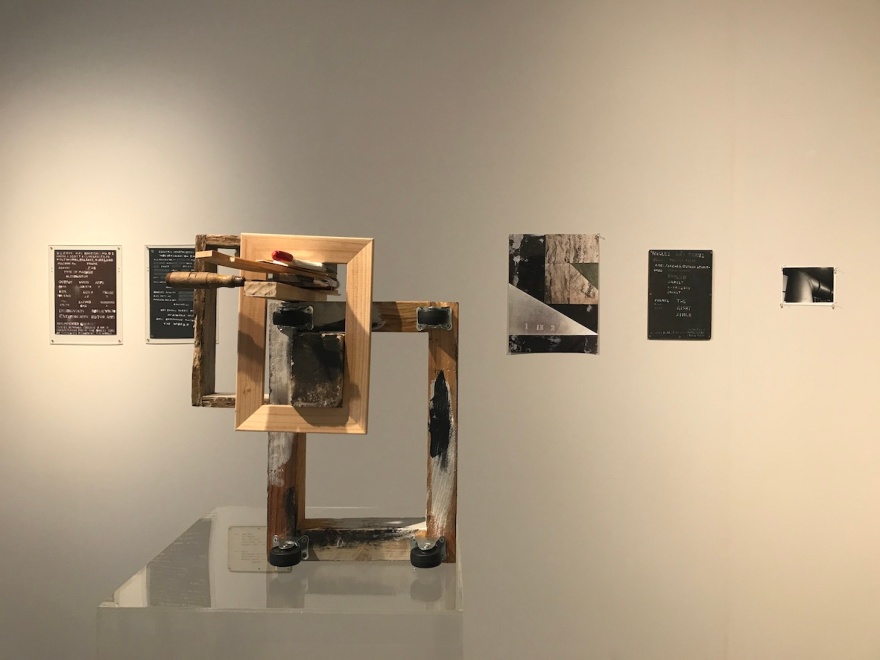THE ENGINEERING DEPARTMENT, Gabrielle Rish + Richard Langley, Moonah Arts Centre, Hobart, 15 September-14 October 2023

Sculpture by Richard Langley with ink drawings and photos by Gabrielle Rish
There is a relationship between those two great human undertakings, art and engineering. Both disciplines are about process, about trying things out and testing materials, seeing what happens and what will work. In my installation-style exhibition with sculptor Richard Langley, The Engineering Department, I pay tribute to the precision and ingenuity of engineers’ problem-solving in my own imprecise way while Richard does so in his more elegant way.
Engineers deal with the monumental forces of nature on a daily basis as they work to build things that harness or withstand those forces and make human life more liveable. The incubator of this technical boldness in my part of the world is the University of Tasmania’s School of Engineering. I’ve know the School of Engineering for as far back as I can remember because my father was a lecturer there. The huge machines for crushing and smashing things, the weird pairs of copper spheres like people conversing with each other, except via static electricity, the mathematical formulas chalked on boards, the smell of machine oil and white noise of generators formed a cross between a technological wonderland and my worst nightmare, made more so because maths and precision, the engineer’s stock in trade, did my girlish head in. But I also loved the technology-age architecture – the reeded glass and wood veneer panelling of the offices, the golden mean-proportioned aluminium-framed windows and the isoceles triangle-patterned lino (the lino sadly covered by carpet just two years ago, but I have photos of it).
I walked back into the Engineering building when I had Latin classes there in 2019 and memories came flooding back. I decided to somehow document this elegantly utilitarian piece of post-war architecture and its contents, especially because the Engineering building and its big machines were slated for the scrap heap with the planned relocation of the campus to the city centre. I spent two weeks in residence in the engineering labs in early 2021, sketching and taking photos. And I was overawed by the machines and the precision of engineering all over again.
After a year of struggling with this big subject matter, I asked Richard if he would co-exhibit with me because his works are brilliantly engineered and he shares my fascination with manufactured objects and materials. It took him a few weeks to agree because he also found engineering a rather daunting subject. But eventually he began to see parallels between engineering and art.
“I was hesitant about the subject matter initially,” Richard said. “I rarely have an outcome in mind when I begin working and I don’t see my work as being particularly logical or calculated. But visiting the School of Engineering and its collection of equipment for testing and measuring, it struck me that engineering tries things to see what happens. It’s about what works, just. The works I’ve made for The Engineering Department are the results of simple experiments. They are some of my initial observations of how these materials and forces can fit together, balance and resist. Their wonky and impermanent forms acknowledge engineering’s human basis.”
I drew in ink for this exhibition, focusing on the dials and nameplates of the machines. Ink can create very precise lines but it is a difficult medium to control due to factors affecting flow like evaporation, absorbency and gravity – engineering-type problems. As we worked in our separate spaces over the course of a year, only occasionally getting together to show and tell, Richard suggested that the imprecise quality that so frustrated me with my ink drawing was actually what spoke to him – it said something about the humanness of engineering.
I found out recently that engineers have a saying, “guess and test”, whereas I had previously thought of them as god-like in their understanding.
Andrew Harper, in his review of The Engineering Department, suggests the show sits ‘in traditions of Dada from the beginnings of the era of new’. My work definitely looks back to a time when the world’s faith in engineers to solve humanity’s problems was at its highest. But that faith has been replaced by a less confident emotion in the past 30 years: hope. Hope that engineers can come up with solutions to climate change, which the ceaseless inventiveness of engineers actually helped create.
More images from the exhibition